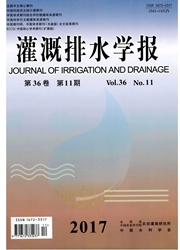

 中文摘要:
中文摘要:
准确评估粮食主产区气象因子变化特征及对参考作物蒸散量(reference crop evapotranspiration,ET0)的影响,对农田水文循环、区域农业水资源优化配置与高效利用等具有重要意义。利用中国粮食主产区258个气象站点1961―2013年的逐日气象资料,采用Penman-Monteith公式计算ET0,通过M-K趋势检验法、偏相关分析、多元线性回归计算贡献率等方法,分析了1961—2013年中国粮食主产区主要气象因子时空演变及其对ET0变化的贡献特征。结果表明,1961—2013年中国粮食主产区相对湿度、温度、降水在空间上由南至北呈降低趋势,而日照时间和风速则由南至北呈增高趋势;1961—2013年中国粮食主产区全区、温带湿润半湿润地区(I区)、温带干旱半干旱地区(II区)、亚热带湿润地区(III区)及暖温带半湿润地区(IV区)多年平均气温均呈增大趋势,平均风速、相对湿度、降水与日照时间均呈减小趋势;1961—2013年中国粮食主产区年内ET0均呈锯齿状下降,且ET0在四季呈现出夏季〉春季〉秋季〉冬季的特征;多年平均风速、气温、日照时间与ET0在全区及各分区总体均显著正相关(P〈0.05),而相对湿度与ET0在全区及各分区均极显著负相关(P〈0.01);1961—2013年中国粮食主产区全区及I-IV区气温、风速、相对湿度对ET0变化均具有较大贡献,其中相对湿度为I区、III区及IV区的主要气象驱动因子,其次为平均气温和风速;而II区ET0变化的主要驱动因子为风速,其平均贡献率WII(风速)为0.37;综上所述,中国粮食主产区主要气象因子变化特征与ET0的响应,均呈现出区域性、季节性差异。
 英文摘要:
英文摘要:
Evaluating meteorological factors and their influence on reference crop evapotranspiration (ET0) plays an important role agricultural production, hydrological processes in natural and managed ecosystems, as well as optimal use of regional agricultural water resources. In this paper, we calculated the ETo using the Penman-Monteith formula and meteorological data measured daily from 1961 to 2013 in 258 meteorological stations in main crop production areas in China. Using the Mann-Kendall method, partial correlation analysis and multi-variable linear analysis, we analyzed the meteorological factors that contributed most to the ETo. The results showed that from the south to the north across the country, the relative humidity, temperature and precipitation in decreased, while the sunshine hours and wind speed increased during the studied period. The average annual temperature in humid sub-humid areas (I), arid and semi-arid areas (II), subtropical humid areas (III) and sub-humid areas (IV) showed an increase over the past 53 years, while the average wind speed, relative humidity, precipitation and sunshine hours in these areas decreased. The ETo calculated in the studied areas decreased continually, and within a year the value of ETo changed in the order of summer〉spring〉autumn〉winter. The ETo was positively related to average annual wind speed, air temperature, sunshine duration (P〈0.05), while negatively related to average relative humidity (P〈0.01). In the past 53 years, the temperature, wind speed, relative humidity contributed most to the ETo in I to IV zones, and the relative humidity was the main meteorological driving force of ETo in I, III and IV zone, followed by average temperature and wind speed. The main driving forceof ETo in zone II was wind speed, and its average contribution rate was 0.37. In summary, the main meteorological factors and their contribution to ETo in main agricultttral production areas in China varied spatiotemporally.
 同期刊论文项目
同期刊论文项目
 同项目期刊论文
同项目期刊论文
 期刊信息
期刊信息
